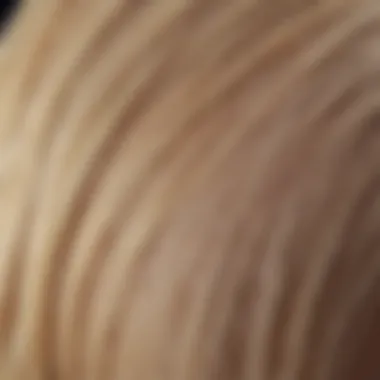Expert Guide on Repairing Hair Damaged from Bleach: Tips & Techniques


Trend Report
When it comes to repairing hair damaged from bleach, it's essential to understand the current trends in hair care. Analyzing the latest developments in hair repair products and techniques can provide valuable insights for effective restoration. By staying abreast of the evolving trends in hair care, individuals can adapt their repair strategies to incorporate the most innovative and beneficial approaches.
Style Guides
In the realm of repairing bleach-damaged hair, having a comprehensive style guide can be invaluable. From essential products to styling tips tailored for damaged hair, a thorough wardrobe for hair health and vitality is necessary. Understanding the body shape and hair texture guides can aid individuals in selecting the most appropriate repair methods to suit their unique needs.
Beauty Tips & Hacks
Repairing hair damaged from bleach often entails delving into a repertoire of beauty tips and hacks. From DIY hair masks to specialized treatments, exploring diverse techniques can enhance the overall repair process. By incorporating skincare routines that nourish the scalp and protect the hair follicles, individuals can promote long-term hair health and resilience.
Understanding Hair Damage from Bleach
Hair damage from bleach is a critical issue that many individuals face due to its adverse effects on hair health and vitality. Understanding the intricacies of how bleach impacts the hair structure is essential in devising effective repair strategies. By delving into the effects of bleach on the cuticle, protein degradation, and moisture loss, one can comprehend the fundamental reasons behind the damage and tailor solutions accordingly.
Effects of Bleach on Hair Structure
Impact on Cuticle
The cuticle, the outermost layer of the hair shaft, is significantly affected by bleach exposure. This leads to cuticle damage, resulting in the loss of natural protection and shine. Understanding the impact on the cuticle is crucial as it influences the overall strength and appearance of the hair. Despite its damaging consequences, addressing cuticle damage is pivotal in hair repair processes, making it a focal point in this article.
Protein Degradation
Proteins in the hair, such as keratin, undergo degradation when exposed to bleach, leading to weakened strands and lack of resilience. Exploring protein degradation sheds light on the core issue of bleach damage and emphasizes the importance of protein restoration in repair treatments. Despite its detrimental effects, understanding protein degradation aids in formulating effective repair techniques, making it a cornerstone in this discussion.
Moisture Loss
One of the prevalent outcomes of bleach damage is the loss of moisture in the hair, resulting in dryness and increased vulnerability. Moisture loss impacts hair texture and manageability, underscoring the significance of hydration techniques in repair processes. By recognizing the effects of moisture loss, individuals can implement targeted solutions to restore optimal hydration levels, making it a pivotal element in repairing bleach-damaged hair.
Common Signs of Hair Damage
Dryness and Brittle Texture
Dryness and a brittle texture are common indicators of bleach-damaged hair. These signs point towards the loss of natural oils and essential nutrients, necessitating interventions to restore hydration and softness. Understanding the characteristics of dryness and brittle texture is crucial in devising moisturizing strategies that rejuvenate the hair effectively.
Split Ends
Split ends, a prevalent issue post-bleaching, signify the weakening of hair strands and lack of structural integrity. Addressing split ends is imperative in preventing further damage and promoting healthy hair growth. Exploring the causes and treatments for split ends equips individuals with the knowledge to tackle this common consequence of bleach damage effectively.


Loss of Elasticity
The loss of elasticity in hair following bleach exposure indicates a reduction in flexibility and strength. Restoring elasticity is essential in maintaining healthy hair and preventing breakage. Delving into the factors contributing to the loss of elasticity offers insights into tailored solutions that revitalize the hair's resilience and flexibility.
Factors Aggravating Bleach Damage
Frequency of Bleaching
Frequent bleaching sessions amplify the damage caused to the hair, leading to increased fragility and dullness. Understanding the repercussions of frequent bleaching highlights the importance of responsible color treatments and maintenance practices. By evaluating the impact of bleaching frequency, individuals can make informed decisions to minimize damage and preserve hair health.
Improper Aftercare Practices
Inadequate aftercare practices, such as using harsh products or neglecting nourishing routines, worsen bleach-induced damage and hinder the repair process. Recognizing the role of proper aftercare is crucial in sustaining hair health post-bleaching. Exploring the effects of improper aftercare unveils strategies for nurturing damaged hair back to its optimal state.
Heat Styling
Excessive heat styling exacerbates bleach damage by depleting moisture and weakening the hair structure. Understanding the impact of heat styling on already compromised hair elucidates the need for protective measures and gentle styling techniques. By acknowledging the repercussions of heat styling, individuals can implement safeguards to mitigate further damage and promote hair recovery.
Assessing the Extent of Damage
Hair damaged by bleach requires a thorough assessment to determine the extent of the harm inflicted on the hair strands. This step is crucial as it lays the foundation for an effective repair strategy. By assessing the damage, individuals can tailor their treatments to address specific issues, leading to better outcomes. Understanding the level of damage allows for the identification of key areas that need attention, such as protein loss, moisture imbalance, and structural weaknesses. Without this evaluation, the repair process may lack precision and fail to deliver desired results. Therefore, assessing the extent of damage serves as the cornerstone for successful hair repair.## Hair Analysis and Consultation
Professional Assessment
Professional assessment plays a pivotal role in evaluating the condition of bleach-damaged hair. This step involves consulting with hair experts who utilize their expertise to diagnose the extent of damage accurately. Hair professionals can conduct in-depth analyses, such as hair strand examinations and microscopic assessments, providing valuable insights into the hair's health. The advantages of professional assessment lie in its accuracy and reliability, offering personalized solutions based on individual needs. However, professional assessments may come at a higher cost compared to DIY methods, making them more suitable for complex or severe cases. Embracing professional assessment ensures a tailored approach to repairing bleach-damaged hair, enhancing the overall effectiveness of the repair process.### DIY Hair Tests Alternatively, individuals can opt for DIY hair tests to assess damage from bleach at home. DIY tests typically involve simple techniques like porosity checks, elasticity tests, and visual inspections. While DIY methods may not offer the same level of precision as professional assessments, they provide a cost-effective way for individuals to gauge the condition of their hair. DIY tests are user-friendly and accessible, allowing individuals to monitor changes in their hair over time. However, the limitations of DIY tests lie in their subjective nature and potential for inaccuracies, especially in identifying underlying issues. Despite these drawbacks, DIY hair tests serve as valuable tools for initial evaluations and can help individuals track their hair's progress between professional consultations.## Identifying Specific Hair Issues
Texture Changes
Texture changes in bleach-damaged hair signify alterations in the hair's structure and feel, indicating underlying damage. These changes may manifest as roughness, frizziness, or loss of natural shine, affecting the overall aesthetics of the hair. Understanding texture changes is important as it guides the selection of suitable hair care products and treatments to restore softness and manageability. By addressing texture concerns, individuals can restore the hair's smoothness and improve its overall appearance.### Scalp Sensitivity Scalp sensitivity is a common issue faced by individuals with bleach-damaged hair, characterized by redness, itching, or inflammation of the scalp. It is essential to address scalp sensitivity as it can impact overall hair health and comfort. Individuals with sensitive scalps may require specialized treatments or gentle hair care routines to prevent further irritation. Identifying scalp sensitivity helps in choosing hair products that soothe the scalp without causing additional discomfort, promoting a healthier environment for hair growth.### Color Alterations Color alterations resulting from bleach damage refer to changes in the hair's hue, tone, or vibrancy. These alterations may include brassiness, fading, or uneven color distribution, affecting the hair's overall appearance. Recognizing color alterations is crucial for selecting color-enhancing treatments or toners to neutralize undesirable tones and restore a harmonious color palette. Addressing color changes ensures that the hair regains its natural or desired shade, enhancing its visual appeal and revitalizing the overall hair look.
Effective Strategies for Repair
Effective strategies for repair play a significant role in addressing hair damage caused by bleach. In this article, we delve into various techniques and methods aimed at restoring hair health and vitality. By prioritizing effective repair strategies, individuals can counteract the negative effects of bleach damage, such as dryness, brittleness, and loss of elasticity. Implementing these strategies not only helps repair current damage but also fortifies the hair against potential future harm. This section focuses on three key elements: moisturizing and hydration techniques, protein rebuilding methods, and preventive measures with routine maintenance.
Moisturizing and Hydration Techniques
Moisturizing and hydration are essential components of repairing bleach-damaged hair. Within this category, we explore the benefits and considerations of three main techniques: deep conditioning treatments, hydrating hair masks, and leave-in conditioners.
Deep Conditioning Treatments
Deep conditioning treatments are indispensable for restoring moisture and nourishment to hair that has been damaged by bleach. Their main advantage lies in their ability to penetrate the hair shaft deeply, providing intense hydration and repairing protein structure. While highly beneficial for repairing damage, excessive use of deep conditioning treatments may lead to product buildup, requiring occasional clarifying treatments.


Hydrating Hair Masks
Hydrating hair masks offer a concentrated dose of hydration and nutrients to dry, damaged hair. Their key characteristic is the ability to coat the hair shaft, sealing in moisture and improving overall elasticity. One unique feature of hydrating hair masks is their versatility in addressing various hair concerns, from frizz to lackluster appearance. However, prolonged use without proper cleansing may result in heaviness or greasiness.
Leave-In Conditioners
Leave-in conditioners serve as a daily maintenance aid in keeping bleach-damaged hair well-hydrated. Their key characteristic is the lightweight formula that moisturizes and detangles hair without requiring rinsing. A unique feature of leave-in conditioners is their versatility, as they can also provide heat protection and enhance styling. However, over-application of leave-in conditioners may weigh down hair over time.
Protein Rebuilding Methods
Protein rebuilding methods are crucial for strengthening and repairing the protein loss in hair damaged by bleach. This section delves into the benefits and considerations of three main methods: protein treatments, keratin infusions, and collagen boosters.
Protein Treatments
Protein treatments are essential for replenishing depleted protein levels in bleach-damaged hair. Their key characteristic lies in their ability to fortify the hair shaft, improving strength and elasticity. A unique feature of protein treatments is their immediate visible results, restoring shine and manageability. However, excessive use of protein treatments may lead to stiffness or brittleness in hair.
Keratin Infusions
Keratin infusions provide a long-lasting solution for restoring protein balance in bleach-damaged hair. Their key characteristic is the ability to bond with existing hair proteins, creating a protective shield against further damage. One unique feature of keratin infusions is their compatibility with various hair types and textures, offering customizable repair solutions. However, keratin infusions require professional application to avoid overexposure and potential buildup.
Collagen Boosters
Collagen boosters play a vital role in enhancing hair elasticity and moisture retention post-bleach damage. Their key characteristic is the ability to plump hair strands, reducing breakage and improving resilience. A unique feature of collagen boosters is their compatibility with other repair treatments, enhancing overall effectiveness. However, collagen boosters may not be suitable for individuals with certain allergies or sensitivities to animal-derived ingredients.
Preventive Measures and Routine Maintenance
Preventive measures and routine maintenance are essential for sustaining the repair efforts on bleach-damaged hair. This section highlights the importance and considerations of three key practices: trimming split ends, heat protectant usage, and gentle styling practices.
Trimming Split Ends
Trimming split ends is a fundamental practice in maintaining hair health post-bleach damage. Its key characteristic lies in preserving the integrity of hair strands by removing damaged ends. A unique feature of trimming split ends is its immediate visual improvement, enhancing hair appearance and manageability. However, excessive trimming without proper hydration may lead to potential breakage or thinning.
Heat Protectant Usage
Heat protectant usage is vital for safeguarding hair from excessive heat styling, especially crucial for bleach-damaged hair. Its key characteristic is the formulation that creates a barrier between heat tools and hair, reducing damage and preserving moisture levels. A unique feature of heat protectants is their versatility, as they can be used on various hair textures and styles. However, inadequate coverage or application may compromise the protective effects, leading to heat-induced damage.
Gentle Styling Practices
Adopting gentle styling practices is essential for preventing further damage and maintaining the repair progress on bleach-damaged hair. The key characteristic of gentle styling lies in minimizing tension and friction on hair strands, reducing breakage and split ends. A unique feature of gentle styling practices is their long-term benefits in promoting hair health and natural texture. However, sudden tension or aggressive manipulation may reverse repair efforts and cause setbacks in hair health.
Professional Interventions and Salon Treatments


In the realm of repairing hair damage from bleach, professional interventions and salon treatments play a pivotal role in restoring hair health. These specialized treatments offer a level of expertise and care that exceeds what can be achieved at home. By consulting hair experts and availing oneself of specialized repair treatments, individuals can address the damage effectively and efficiently. Professionals in the field, including trichologists, hair stylists, and color specialists, bring a wealth of knowledge and experience to the table, ensuring a tailored and effective approach to hair repair. These experts can assess the extent of damage, recommend appropriate treatments, and provide guidance on post-treatment care.
Consulting Hair Experts
Trichologists:
Trichologists, distinguished by their focus on scalp and hair health, bring a unique perspective to the repair process. Their specialized knowledge allows them to analyze the root causes of damage, recommending personalized treatments to address specific issues. Trichologists are known for their holistic approach, considering not just the current damage but also factors contributing to long-term hair health. While their services may come at a higher cost, the expertise they provide can be invaluable in achieving lasting results.
Hair Stylists:
Hair stylists contribute their expertise in styling and hair care to the repair journey. Beyond just recommendations for treatments, they can advise on suitable hairstyles that minimize the appearance of damage while promoting hair recovery. With their practical knowledge of hair products and styling techniques, hair stylists add a versatile dimension to the repair process, ensuring that the hair both looks and feels its best.
Color Specialists:
For those grappling with bleach-related color issues, color specialists offer targeted solutions. Their in-depth understanding of color theory enables them to correct uneven tones, discoloration, or unwanted shades caused by bleach damage. By customizing color treatments to each individual's needs, color specialists can achieve natural-looking results while preserving hair health.
Specialized Hair Repair Treatments
In addition to expert consultations, specialized hair repair treatments like Olaplex treatments, Brazilian blowouts, and scalp treatments provide tailored solutions for damaged hair. Each of these treatments addresses specific aspects of damage, whether it's strengthening weakened strands, restoring moisture balance, or revitalizing the scalp. By incorporating these specialized treatments into a hair repair regimen, individuals can expedite the recovery process and maintain the health of their hair in the long run.
Olaplex Treatments:
With its focus on repairing disulfide bonds within the hair shaft, Olaplex treatments excel at strengthening and fortifying damaged hair. By reintroducing essential bonds that may have been broken by bleach, Olaplex helps improve hair elasticity, texture, and overall resilience. This treatment is especially beneficial for individuals with extensive bleach damage seeking a reliable repair solution.
Brazilian Blowouts:
Known for their smoothing and rejuvenating effects, Brazilian blowouts are ideal for tackling frizz, dryness, and dullness resulting from bleach damage. This treatment involves a keratin-infused formula that coats the hair, providing a protective layer against environmental stressors and heat styling. Brazilian blowouts not only enhance the appearance of the hair but also enhance its manageability and shine.
Scalp Treatments:
Scalp treatments focus on nurturing the scalp environment, which is often neglected yet critical for healthy hair growth. By addressing scalp issues such as dryness, itchiness, or inflammation, these treatments create an optimal foundation for hair repair. Scalp treatments not only promote hair growth but also enhance the efficacy of hair products and treatments applied subsequently.
Professional Color Corrections
For individuals seeking to rectify bleach-induced color issues, professional color corrections offer a tailored approach to achieving desired hair hues. Color balancing, toning treatments, and color-enhancing services cater to diverse color correction needs, ensuring that individuals can regain color confidence without compromising hair health.
Color Balancing:
Color balancing treatments aim to neutralize unwanted undertones or brassiness in the hair, creating a harmonious and natural-looking color result. By expertly adjusting the tone and depth of the hair color, color balancing treatments restore balance and vibrancy to bleach-damaged hair. This process involves precise color application and formulation to achieve the desired shade.
Toning Treatments:
Toning treatments, popular for their ability to refine and enhance hair color, are beneficial for individuals with bleach-induced color shifts. By depositing specialized pigments to counteract unwanted tones, toning treatments bring hair color back to its desired shade. Whether aiming for cool, warm, or neutral tones, toning treatments offer a versatile and effective solution for color correction.
Color-Enhancing Services:
To elevate the overall appearance of bleach-damaged hair, color-enhancing services provide a multidimensional approach to color correction. These services may include gloss treatments, color overlays, or highlighting techniques to enhance the natural beauty of the hair. By incorporating color-enhancing services into a hair repair regimen, individuals can achieve personalized and striking color results that complement their overall look.



